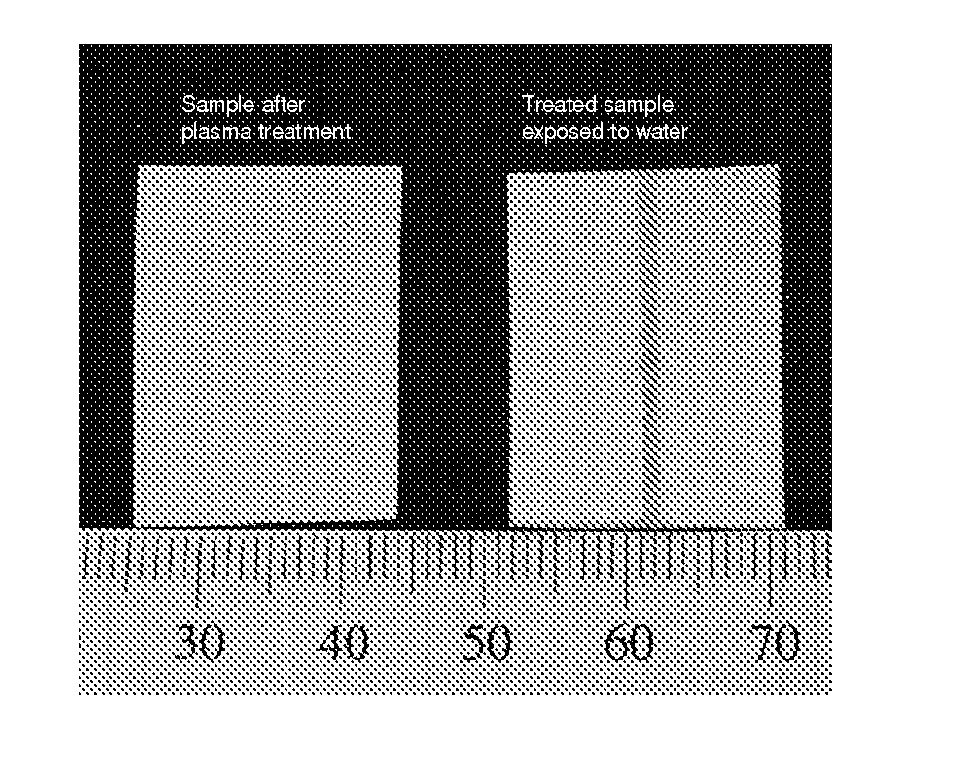Method of fabricating microfluidic systems
a microfluidic system and microfluidic technology, applied in the field of microfluidic systems, can solve the problems of poor channel resolution and definition, rigid and brittle barriers which can be easily damaged, physical barriers which define the periphery of microchannels, etc., and achieve the effect of fast change and low cos
- Summary
- Abstract
- Description
- Claims
- Application Information
AI Technical Summary
Benefits of technology
Problems solved by technology
Method used
Image
Examples
example 1
[0047]In one embodiment of the invention as shown in FIG. 1, a filter paper was hydrophobized by immersion in a solution of AKD dissolved in heptane and the solvent was allowed to evaporate. A heat treatment of the treated paper in an oven at 100° C. for 30-50 minutes was applied. In the second step, a solid mask was applied to the paper substrate and the system was exposed to a plasma reactor (K1050X plasma asher (Quorum Emitech, UK) for 10-100 seconds at the intensity of 12-50 W). The plasma treatment left no visible mark on the sample and the sample retained its original softness and flexibility. The treated channel becomes wettable by aqueous solutions and allows the capillary transport of the solutions. The width of the channel can be well controlled. FIG. 1 shows a single channel treated with a mask of 1 mm in width on filter paper, and shows the channel before and after wetting by water.
[0048]The treated channel can have any geometrical pattern as shown in FIG. 2. First, a pa...
example 2
[0050]In a second embodiment of the invention as shown in FIG. 3, micro-channels were formed onto composites cellulosic materials. A two-ply Kleenex mainline facial tissue was treated similarly to example 1. FIG. 3 represents the liquid filled micro-channels on Kleenex two-ply tissue.
example 3
[0051]In a third embodiment of the invention as shown in FIG. 4, micro-channels were formed onto a layered and molded paper basesheet. A three-layer molded paper towel (Kimberly-Clark Viva) was treated similarly to example 1. FIG. 4 represents the liquid filled micro-channels on three-layer Kimberly-Clark Viva towel.
PUM
| Property | Measurement | Unit |
|---|---|---|
| width | aaaaa | aaaaa |
| length | aaaaa | aaaaa |
| width | aaaaa | aaaaa |
Abstract
Description
Claims
Application Information
 Login to View More
Login to View More - R&D
- Intellectual Property
- Life Sciences
- Materials
- Tech Scout
- Unparalleled Data Quality
- Higher Quality Content
- 60% Fewer Hallucinations
Browse by: Latest US Patents, China's latest patents, Technical Efficacy Thesaurus, Application Domain, Technology Topic, Popular Technical Reports.
© 2025 PatSnap. All rights reserved.Legal|Privacy policy|Modern Slavery Act Transparency Statement|Sitemap|About US| Contact US: help@patsnap.com



